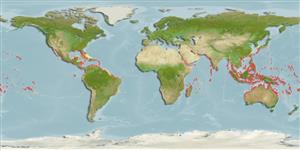Common names from other countries
>
Syngnathiformes (Pipefishes and seahorses) >
Syngnathidae (Pipefishes and seahorses) > Nerophinae
Etymology: Microphis: Greek, mikros = small + greek, ophis = serpent (Ref. 45335).
More on author: Bleeker.
Environment: milieu / climate zone / depth range / distribution range
Ecologia
marinhas; Água doce; estuarina demersal; anádromo (Ref. 51243); intervalo de profundidade 0 - 5 m (Ref. 86942). Subtropical; 35°N - 32°S
Asia and Oceania: Sri Lanka, southern India, Nicobar Islands and eastward to Japan and the Society Islands. Records from Puerto Rico and USA need confirmation. Africa: east coast from Kenya south to KwaZulu-Natal area, also Madagascar and Mauritius (Ref. 7248, 52193). Africa: Côte d'Ivoire (Ref. 272). Western Atlantic: Atlantic coast of Florida, Bahamas, northern and southern Gulf of Mexico, Antilles, central and south American coasts to Brazil (Ref. 26938).
Comprimento de primeira maturação / Tamanho / Peso / Idade
Maturity: Lm ?, range 12 - ? cm
Max length : 22.0 cm SL macho/indeterminado; (Ref. 5316)
Espinhos dorsais (total) : 0; Raios dorsais (total) : 37 - 54; Espinhos anais: 0; Raios anais : 4.
Occurs in relatively shallow (25-150 cm), still to slow-flowing water (Ref. 6028). Inhabits freshwater streams, rivers and estuaries. Juveniles and subadults are usually found in estuaries while adults are found upstream in freshwater areas. Feeds on worms, crustaceans and zooplankton. Ovoviviparous (Ref. 205). The male carries the eggs in a brood pouch which is found under the tail (Ref. 205). Not seen in markets (Ref. 12693)
Ciclo de vida ou comportamento de acasalamento
Maturities | Reprodução | Spawnings | Egg(s) | Fecundities | Larvas
Female deposits eggs on the ventral surface of the male trunk's or tail , where they are incubated for several weeks. Males may be brooding at 12 cm SL (Ref. 5316).
Dawson, C.E., 1985. Indo-Pacific pipefishes (Red Sea to the Americas). The Gulf Coast Research Laboratory Ocean Springs, Mississippi, USA. (Ref. 5316)
Status na Lista Vermelha da UICN (Ref. 130435)
CITES (Ref. 128078)
Not Evaluated
Ameaça para os humanos
Harmless
Uso pelos humanos
Pescarias: sem interesse; Aquário: Espécies comerciais
Ferramentas
Relatórios especiais
Baixar XML
Fontes da internet
Estimates based on models
Preferred temperature (Ref.
115969): 25.4 - 29.2, mean 28.1 (based on 3402 cells).
Índice de diversidade filogenética (Ref.
82804): PD
50 = 0.5000 [Uniqueness, from 0.5 = low to 2.0 = high].
Bayesian length-weight: a=0.00085 (0.00032 - 0.00224), b=3.04 (2.81 - 3.27), in cm Total Length, based on LWR estimates for this (Sub)family-body shape (Ref.
93245).
Nível Trófico (Ref.
69278): 3.3 ±0.41 se; based on food items.
Resiliência (Ref.
120179): Elevada, tempo mínimo de duplicação da população menor que 15 meses (Preliminary K or Fecundity.).
Fishing Vulnerability (Ref.
59153): Low vulnerability (17 of 100).
